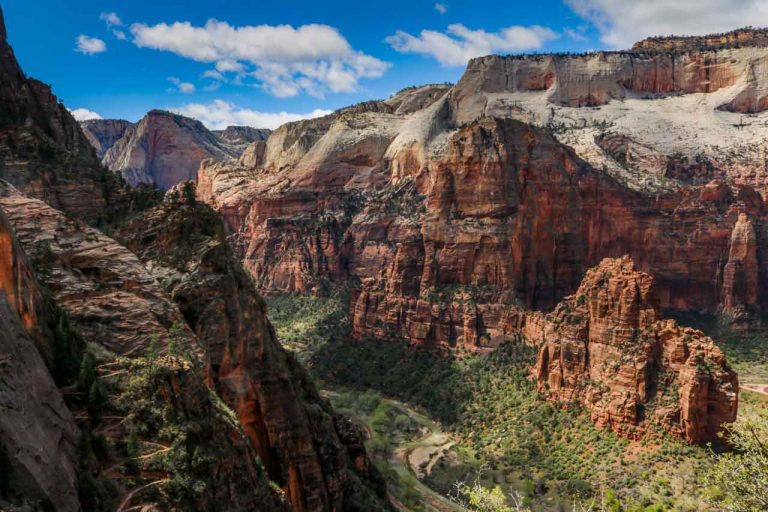7 Fascinating Historic Ruins in Virgin Islands National Park
Virgin Islands National Park encompasses a large part of the island of St. John, one of the three main U.S. Virgin Islands, which is dotted with numerous fascinating historic sites and plantation ruins.
In the course of its history, the island has gone through times of displacement of its original inhabitants, European colonization, and slavery at Danish-owned sugar plantations, some of which are now fascinating ruins that are accessible to park visitors.
In this blog post, I’ll share with you a handful of amazing historic sites and sugar plantation ruins in Virgin Islands National Park.
From the overgrown remains of so-called “great houses” to entire sugar factory complexes, these sites tell a critically important part of the story of the U.S. Virgin Islands.
Dating from the 17th through the 19th centuries, I consider them among the “must-visit” attractions in the park.
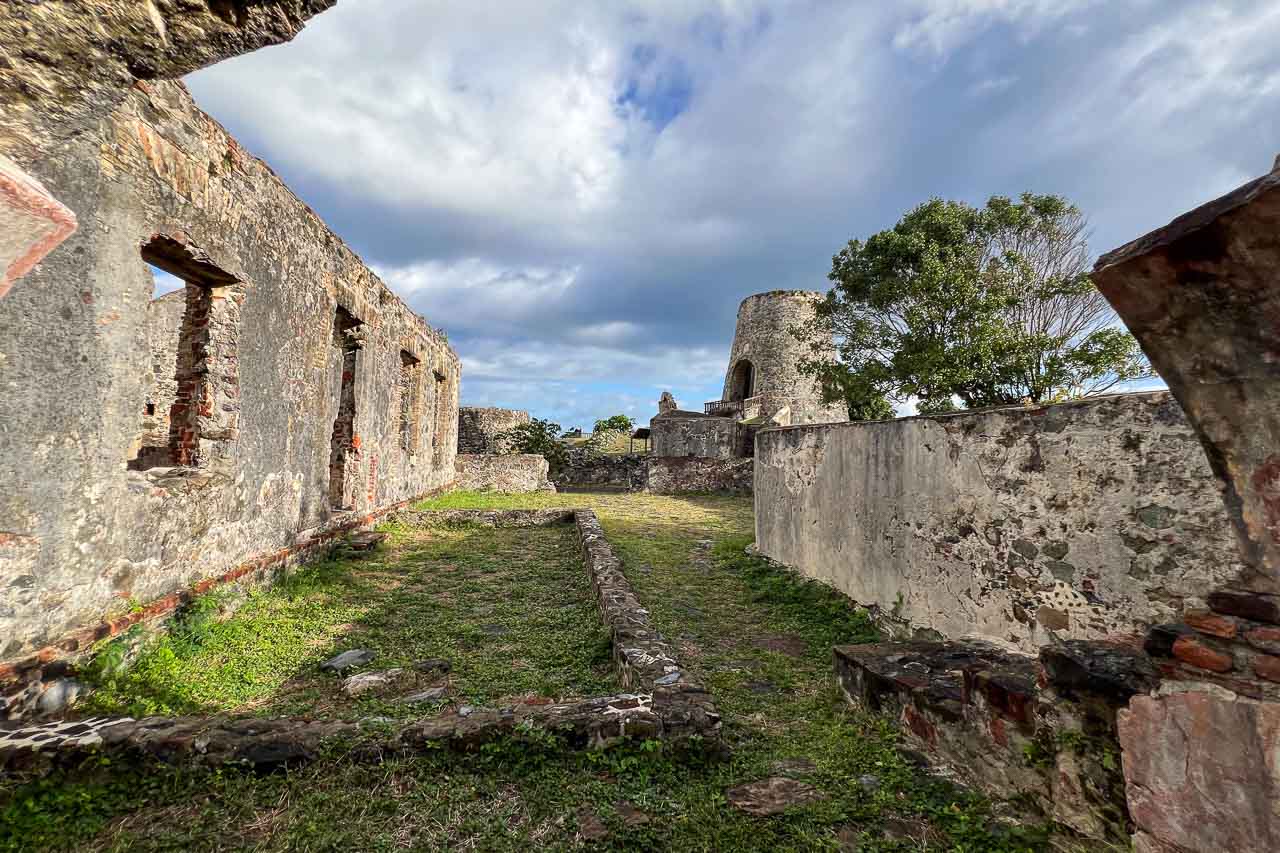
This blog post about the plantation ruins in Virgin Islands National Park contains affiliate links. If you click on one of those links and make a purchase from one of our partners, we may earn a commission, without any extra cost to you. This helps support this website and ensures fair compensation for our team.
Top 7 Historic Ruins in Virgin Islands National Park
I’ve explored all these sites and ruins myself—along with some others than didn’t make the list—and I really do recommend visiting as many as you can.
If your time in the park is limited, however, I still suggest picking two to three of these places, simply because they’re such an essential feature of both the national park and the island of St. John.
To make your choice a bit easier, I listed these Virgin Islands ruins in a top-list format. If you must choose, opt for the sites and plantation ruins at the end of the list. They’re the “best,” most scenic, and/or most expansive ones.
7. Peace Hill Windmill Ruins
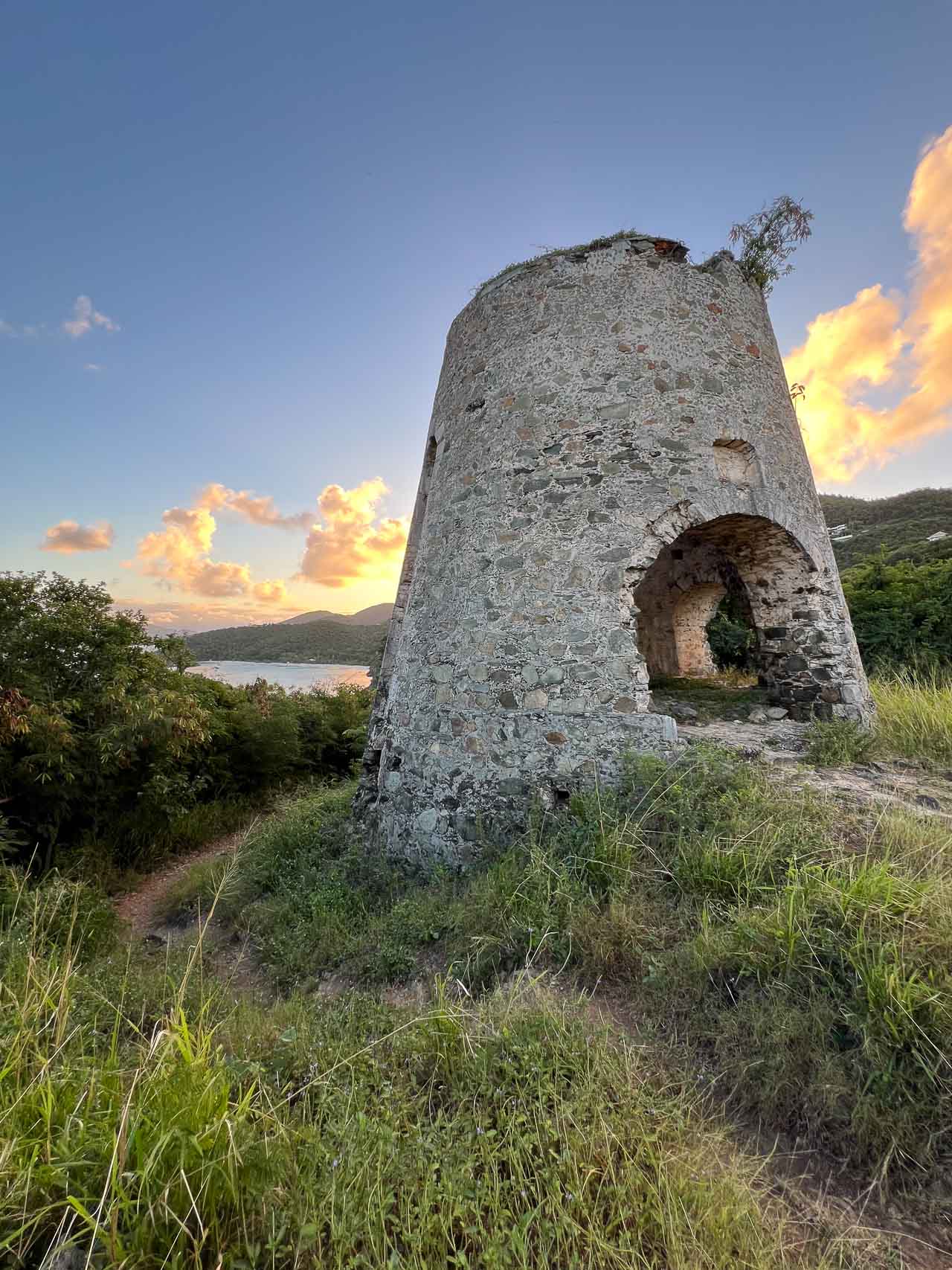
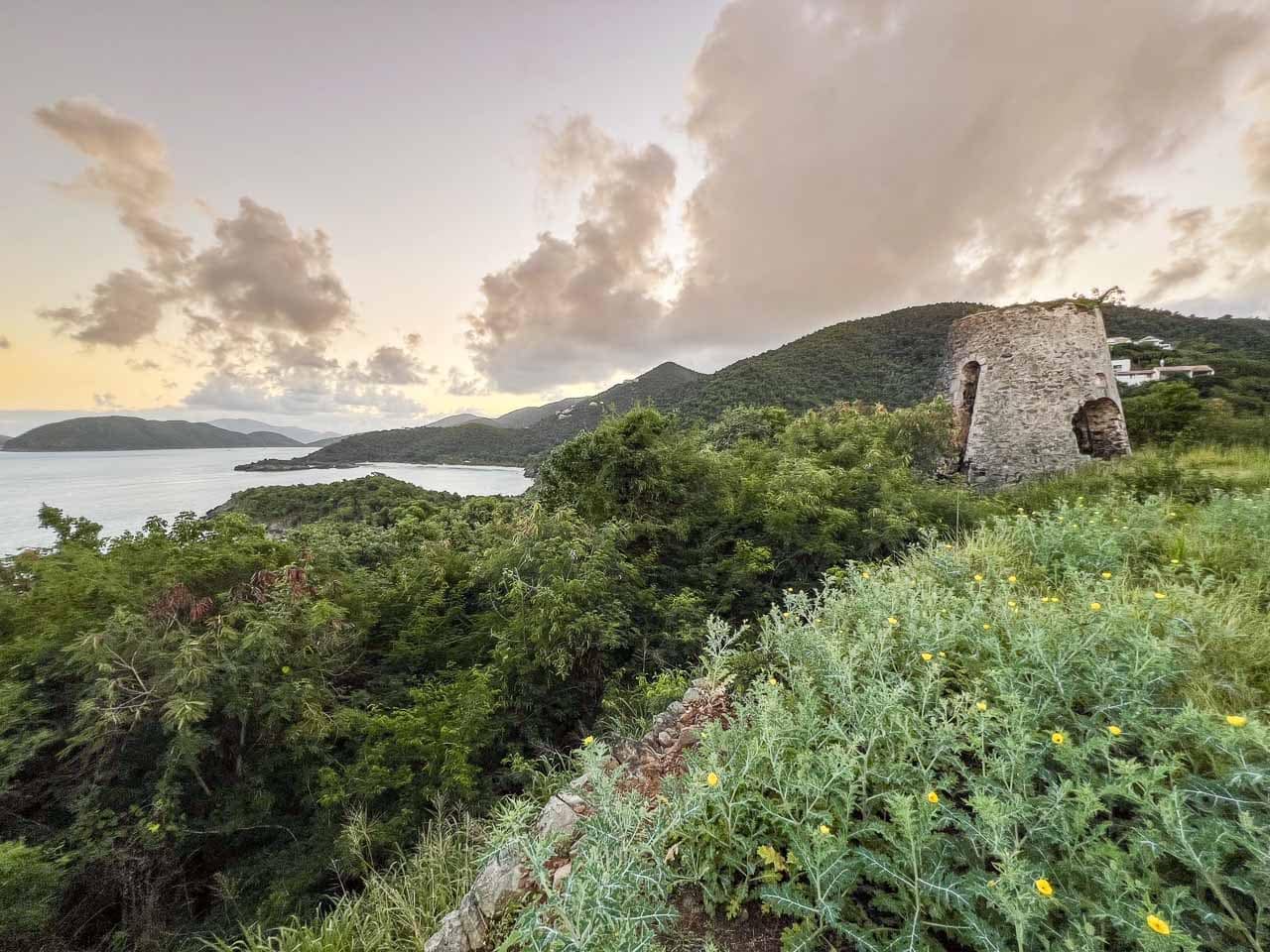
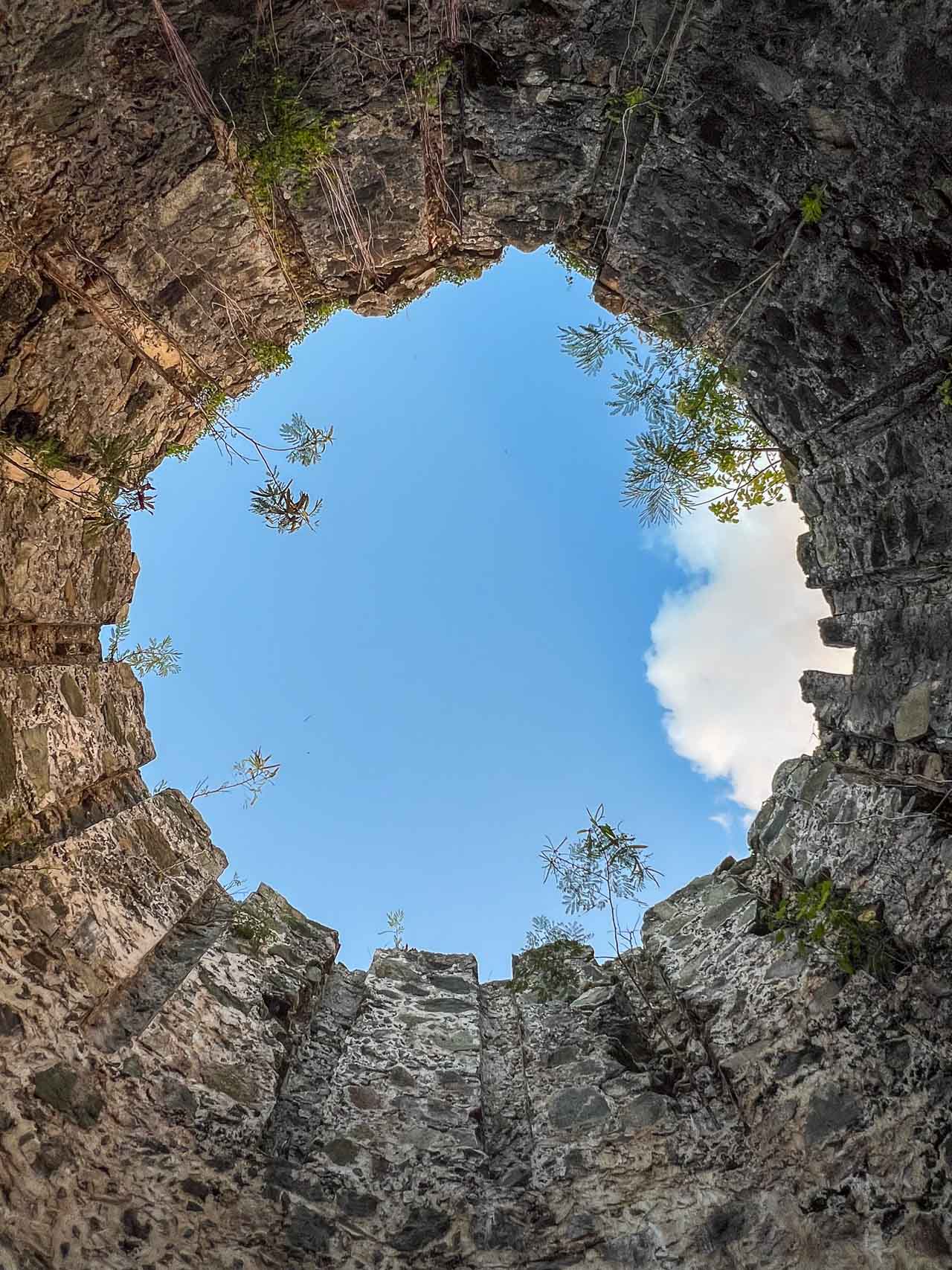
As scenic as its location and views are, the Peace Hill Windmill Ruins are quite small compared to the other Virgin Islands ruins in this list. It’s still very much worth visiting, though.
As its name implies, these ruins are a former windmill situated atop a hill. The windmill is one of the last remains of what was once the nearby Denis Bay Plantation.
A very short trail leads from a parking lot on North Shore Road, halfway between Hawksnest and Trunk Bay. It’s only about 0.1 miles one way, which doesn’t take longer than just a few minutes.
You can walk through the windmill ruins atop Peace Hill, enjoying the beautifully framed views through its windows. As you explore the hilltop, which has a very appropriate name—especially in the morning it’s an incredibly tranquil place—you can enjoy stunning panoramic views of Hawksnest Bay and famous Trunk Bay.
While the ruins themselves are much less expansive than others in Virgin Islands National Park, this is nonetheless a great place to visit. In fact, I consider the views from Peace Hill to be among the absolute best in the entire park!
6. Catherineberg Plantation Ruins
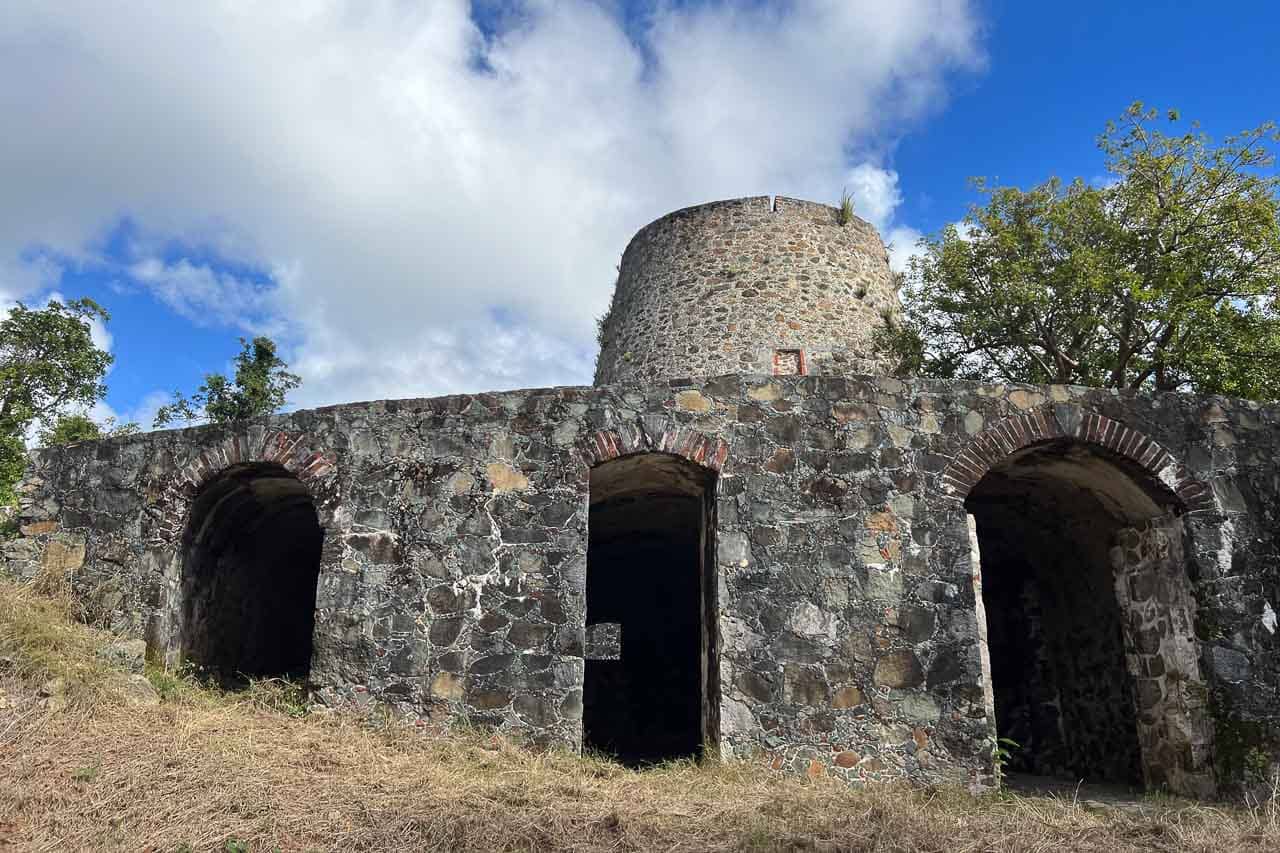
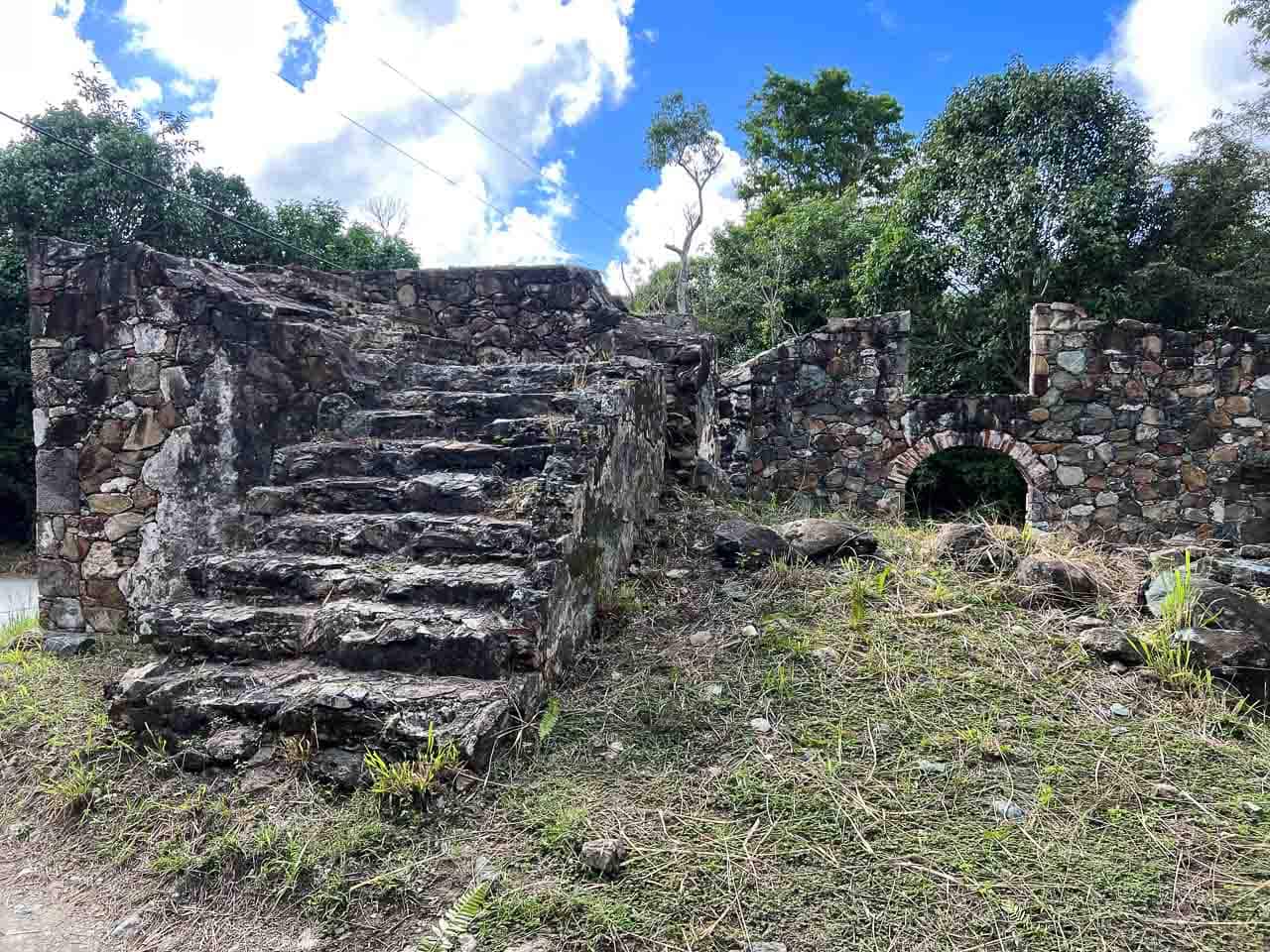
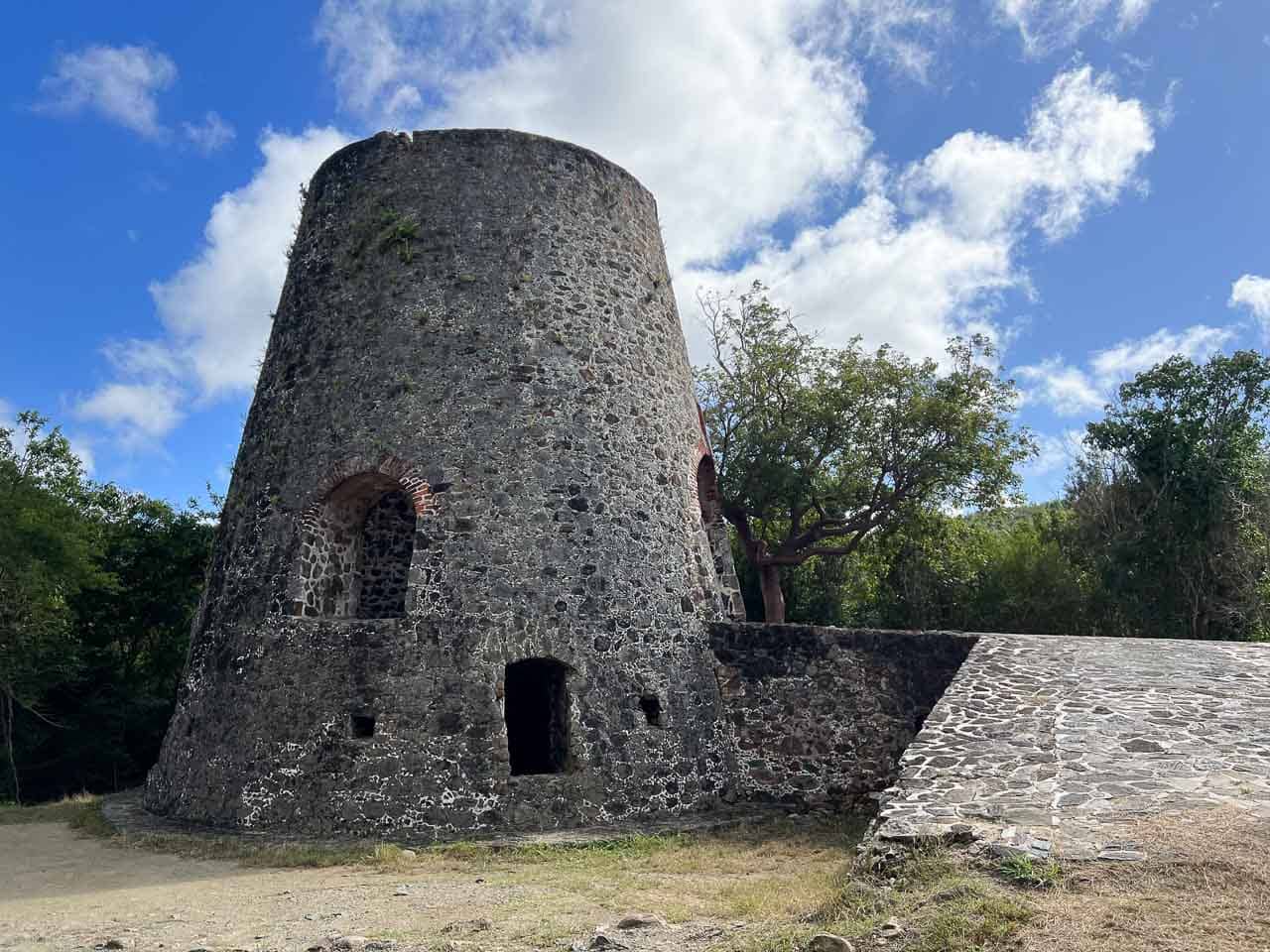
Located along Centerline Road, the Catherineberg Plantation Ruins are the remains of a once-sprawling sugar plantation complex in the heart of St. John.
Although much less developed for visitors than the plantations at Annaberg and Cinnamon Bay, for example, it does “show a well-preserved Danish colonial period site,” the National Park Service says.
Just like other sugar mill operations on the island, Catherineberg had an enslaved workforce that produced sugar in often brutal conditions. Among the best preserved buildings at Catherineberg are the windmill and the boiling house.
To get there, you can park just off of Centerline Road and walk to the ruins, or hike up the rough gravel road from the base of the hill near Cinnamon Bay.
5. America Hill Great House Ruins
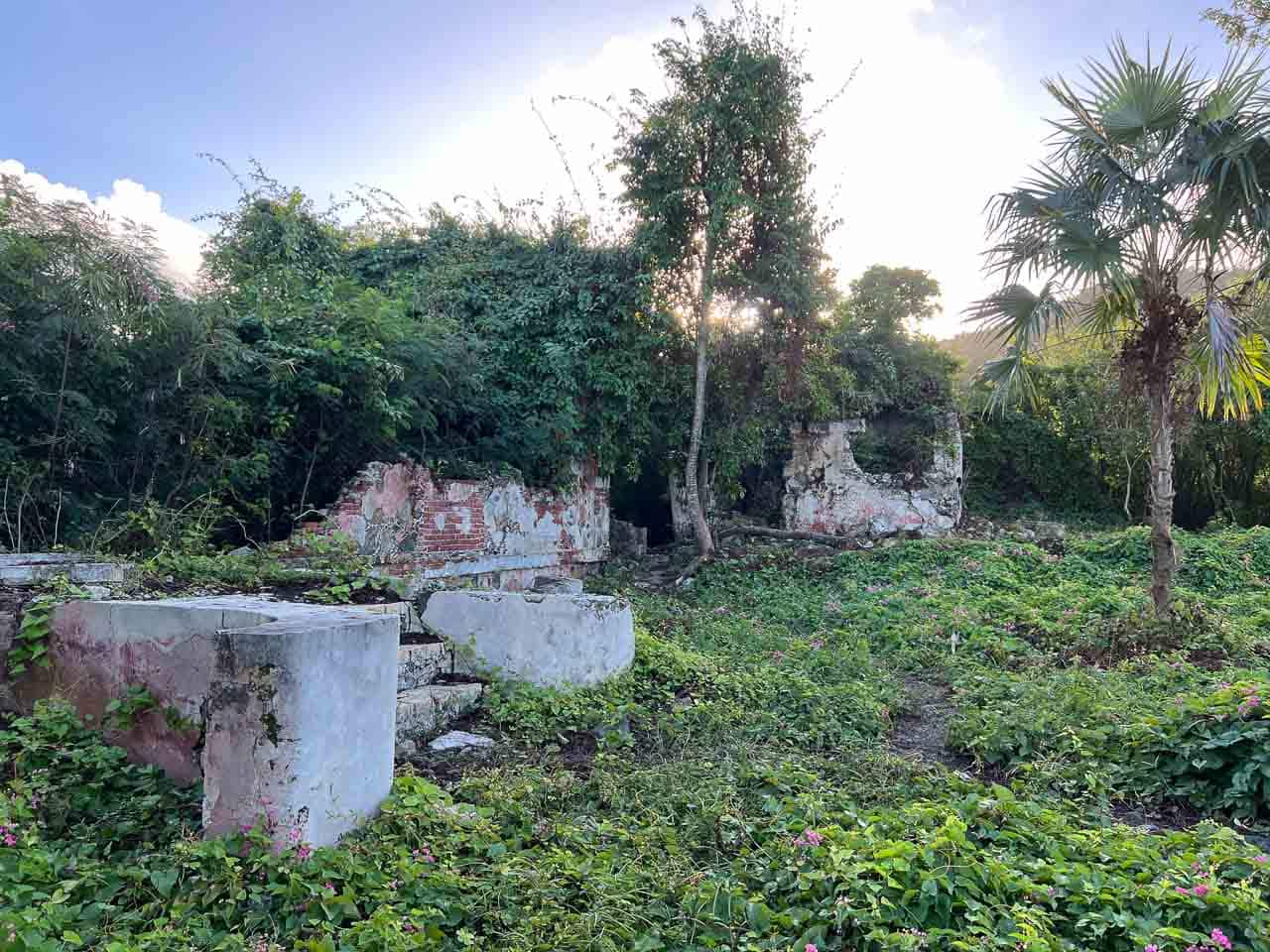
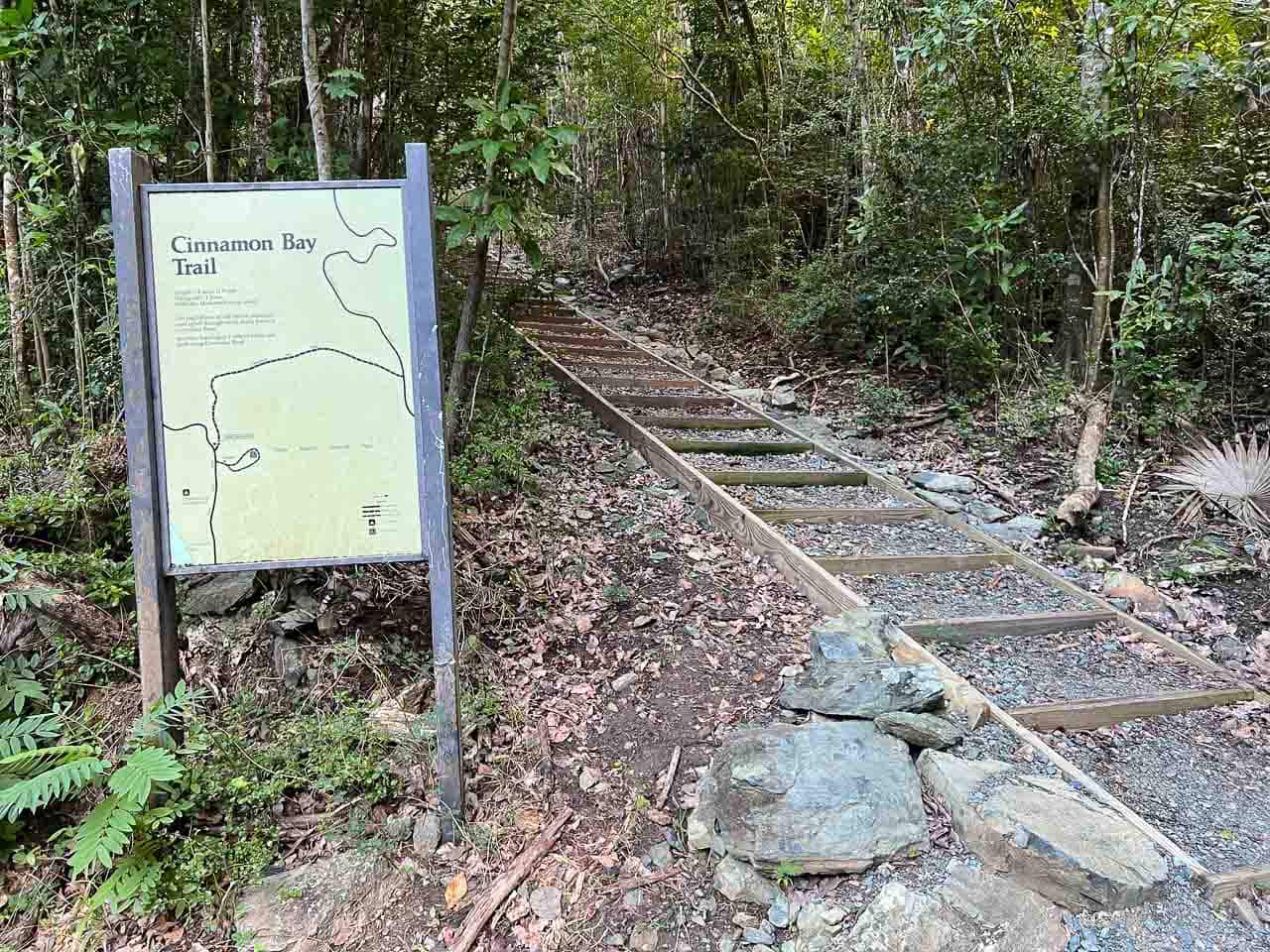
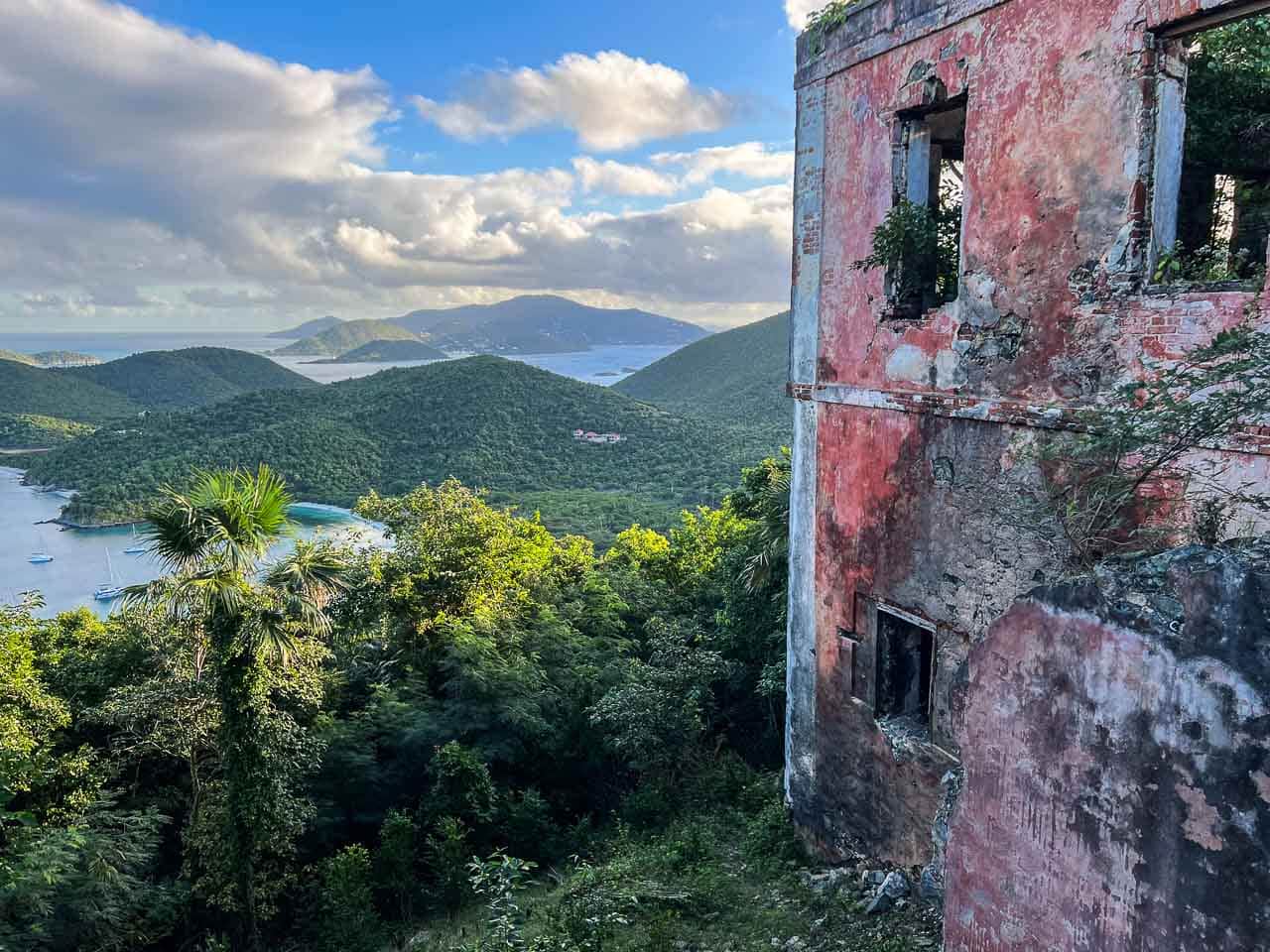
One of my favorite hikes in Virgin Islands National Park is the Cinnamon Bay Trail to the America Hill Great House Ruins.
The trail starts right next to the Cinnamon Bay Plantation Ruins (see below), so it’s very easy to combine the two. It’s approximately 1.3 miles there and back, a fun—and potentially humid—one-hour hike through a tropical forest to the ruins.
For a fun afternoon, I suggest hiking the Cinnamon Bay Trail and exploring the Cinnamon Bay Plantation Ruins, followed by some relaxing on Cinnamon Bay Beach.
The ruins of the great house at America Hill used to be part of an estate owned by a wealthy European colonizer. In the early-1900s, it also served as a guest house for island visitors.
In my opinion, the America Hill Great House Ruins are one of the most underrated historic places in Virgin Islands National Park. Despite being quite weathered down and partially overgrown with vegetation, you can still see the buildings’ beautiful pink color.
Additionally, the view from the ruins is nothing short of breathtaking. It takes in the north coast of St. John, Maho Bay, Francis Bay, and a number of other Caribbean islands in the distance.
4. Reef Bay Sugar Factory Ruins
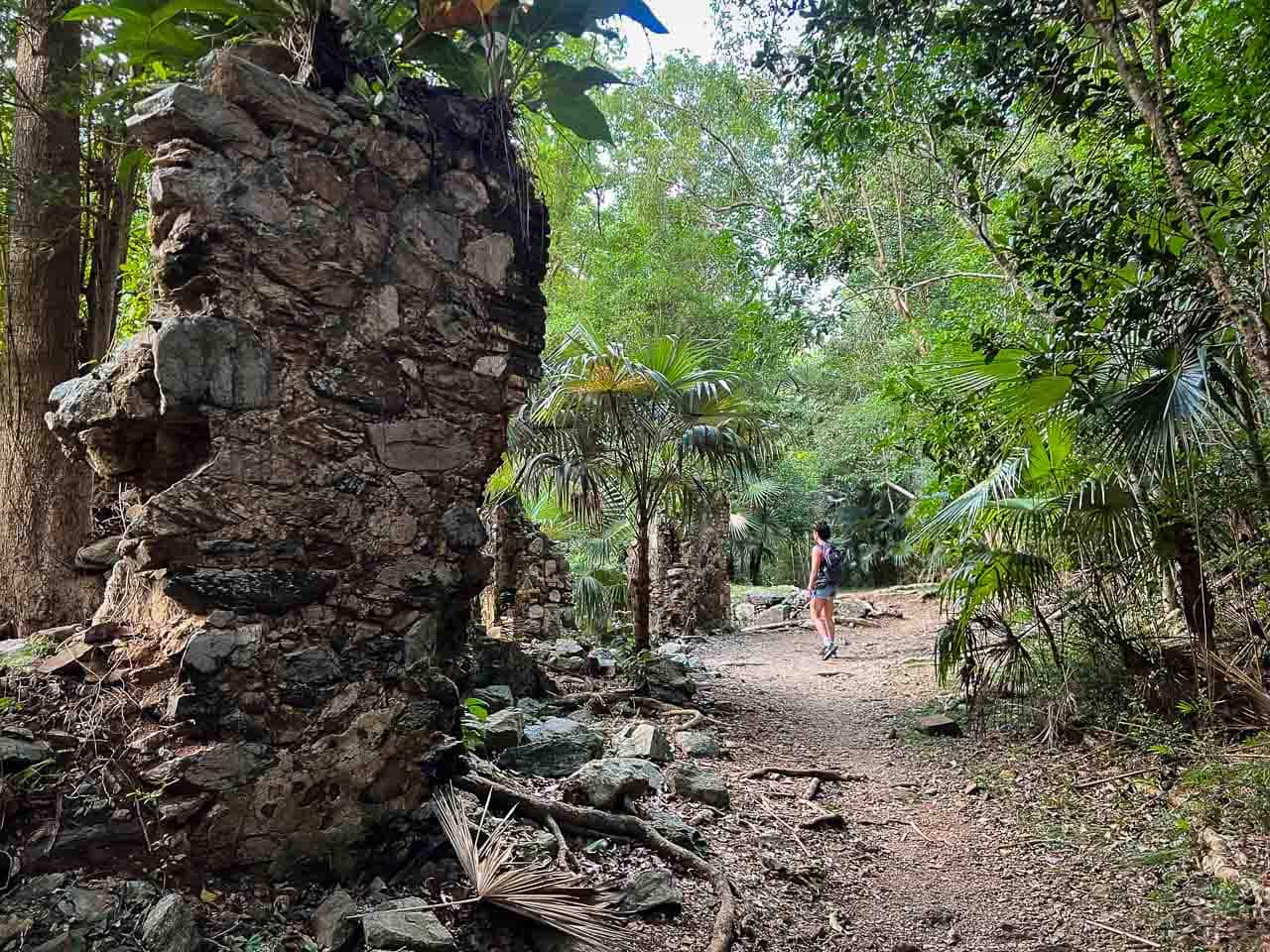
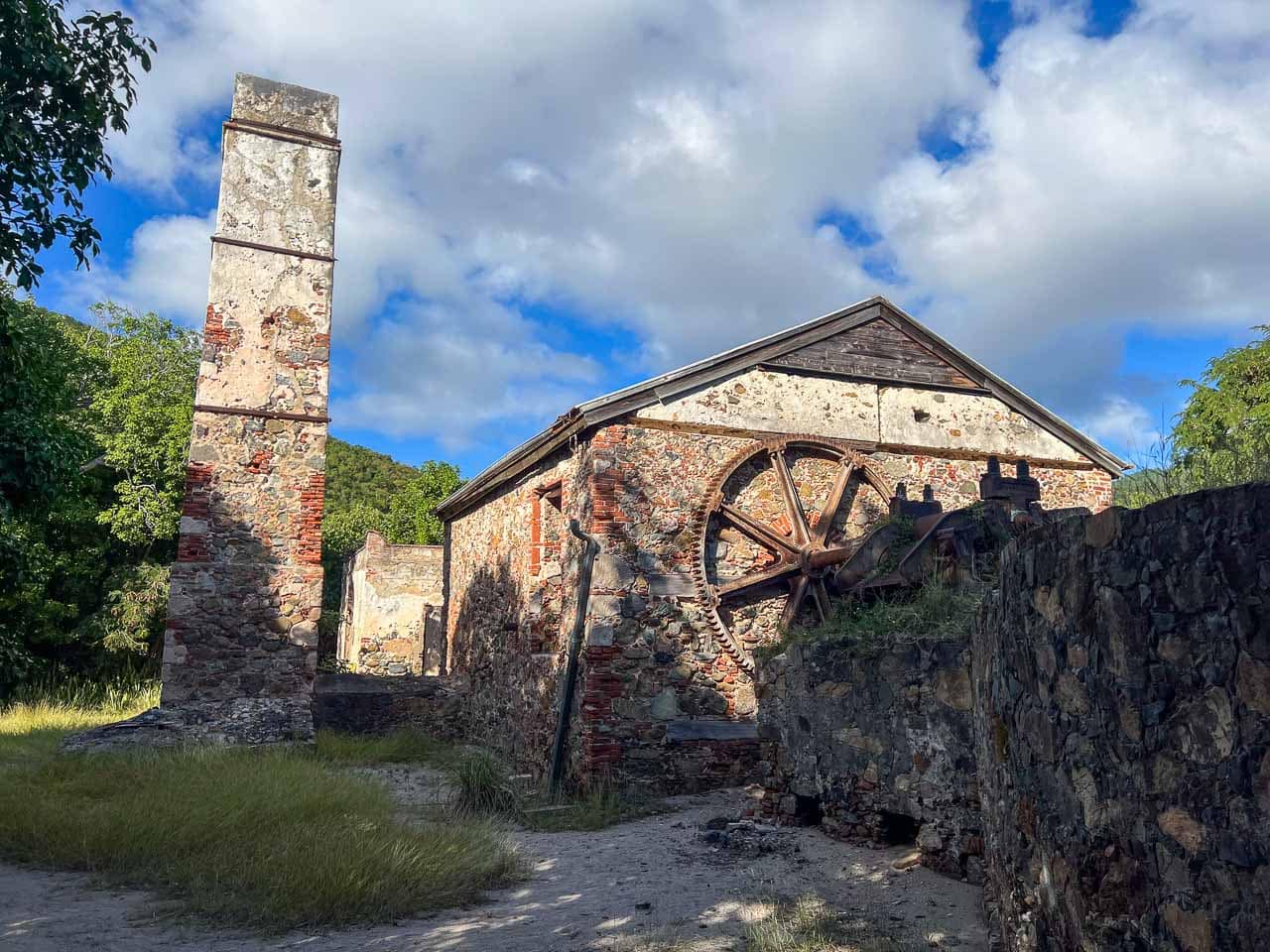
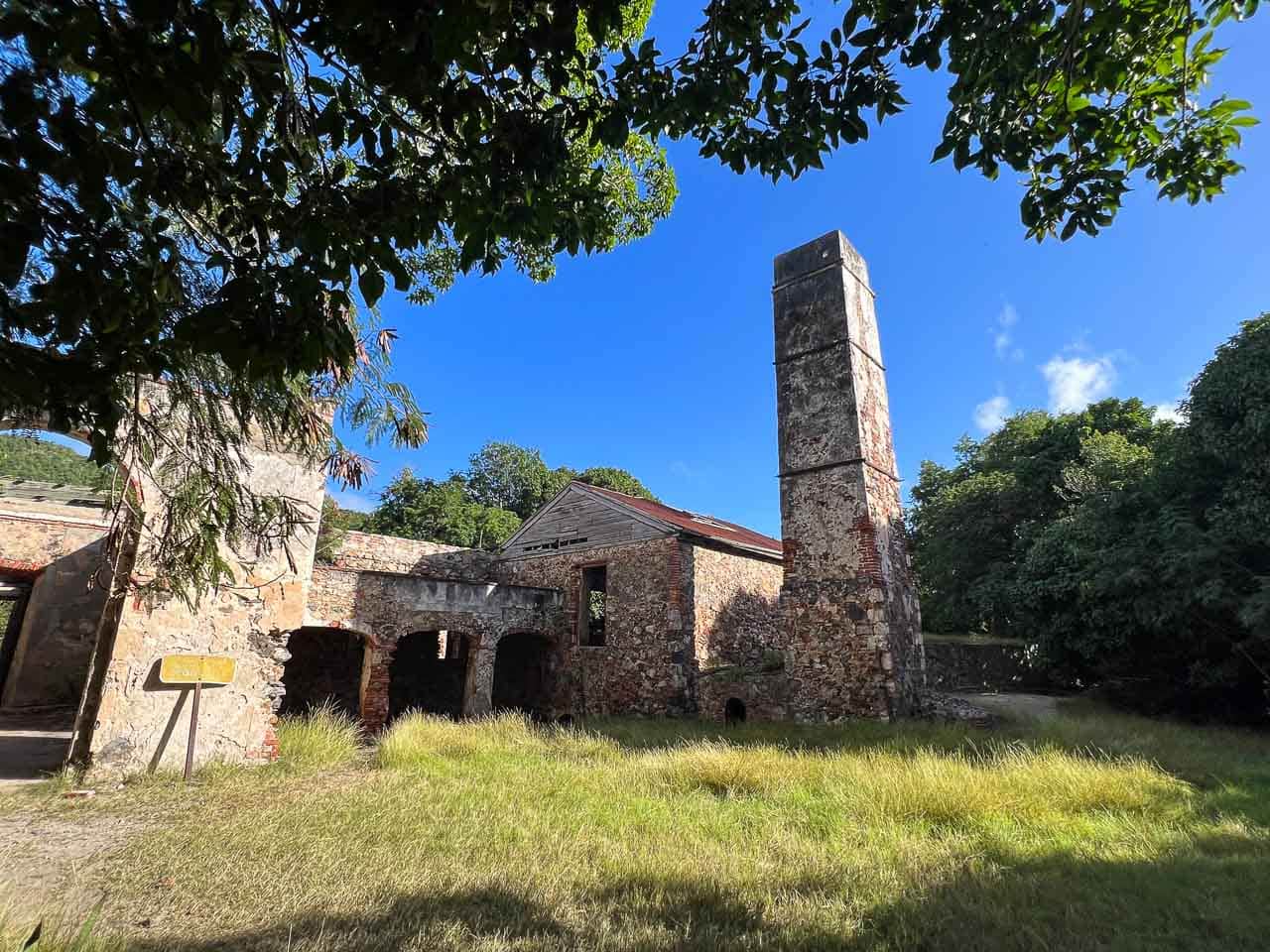
One of the most fascinating and best preserve sugar plantation ruins in Virgin Islands National Park lies near the end of one of the park’s most challenging trails: the 4.4-mile roundtrip Reef Bay Trail.
Starting in the middle of the island on Centerline Road, this fantastic trail runs all the way down to Reef Bay on the south shore of St. John. On the way, it passes by a number of other ruins, walls once used for cattle grazing, and a spur trail to pre-Columbian Taino petroglyphs.
Just before you get to the beach at Reef Bay, you’ll come across the magnificent ruins of the Reef Bay Sugar Factory.
Now part of a national historic district, the Reef Bay Sugar Factory was the last operational sugar mill on St. John. It continued its operations into the early-1900s, long after slavery was abolished in the Danish West Indies.
Among its many fascinating aspects is the cast iron steam engine that was added to its “engine room” in 1862—a unique feature among the plantations in Virgin Islands National Park.
In addition to the engine room, the ruins also comprise a horse mill, bake oven, sugar factory, cemetery, and a few small dwellings.
TIP: This is one of the longest and most strenuous day hikes in Virgin Islands National Park. Certain sections of the trail are quite steep and most of it is through humid tropical forest. Brings plenty of water, salty snacks, bug repellent, reef-safe sunscreen, and a hat. Additionally, I’d also like to tell you about the many hermit crabs you’ll see on the trail. Be careful not to step on them!
3. Murphy Great House Ruins
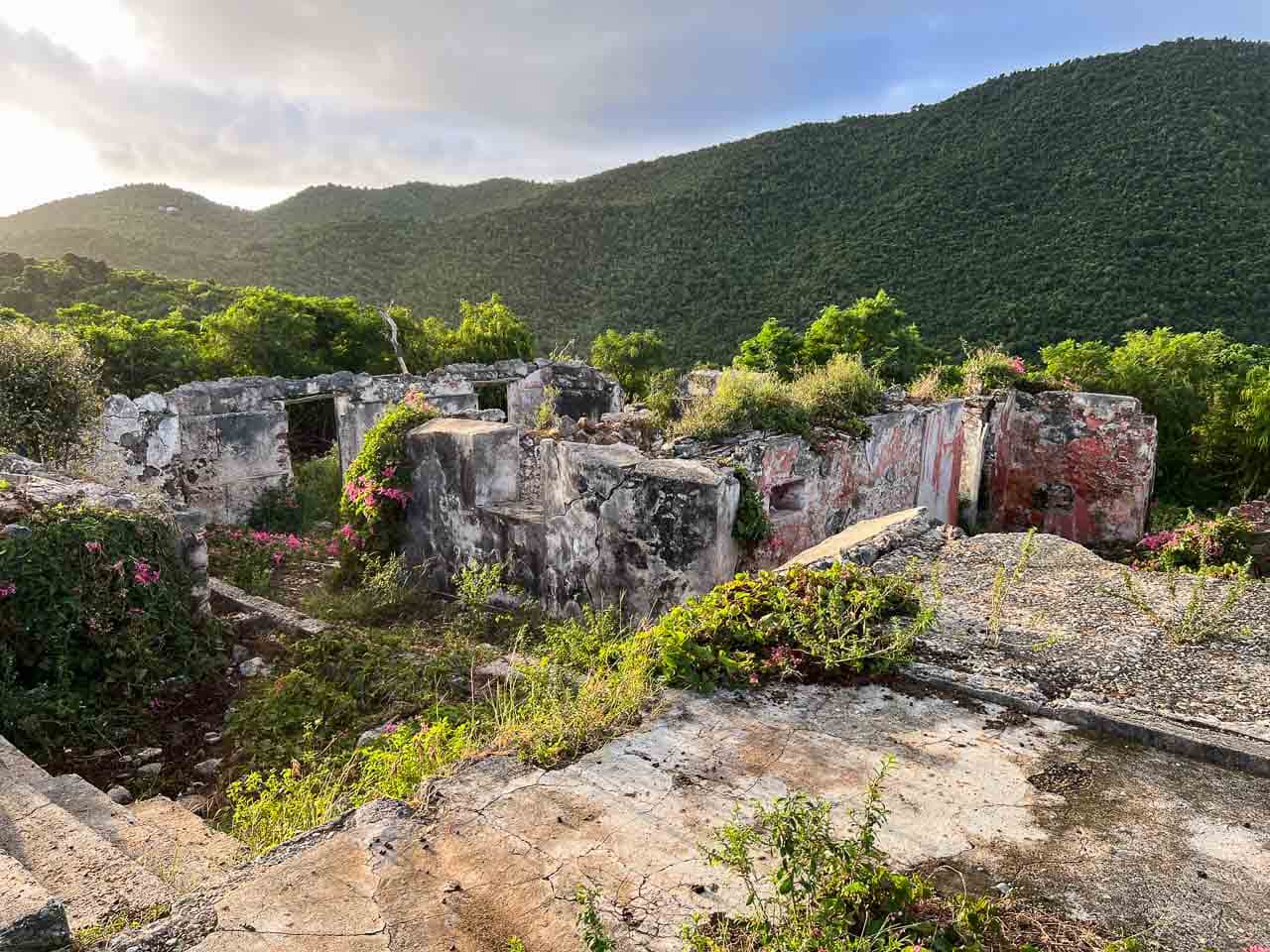
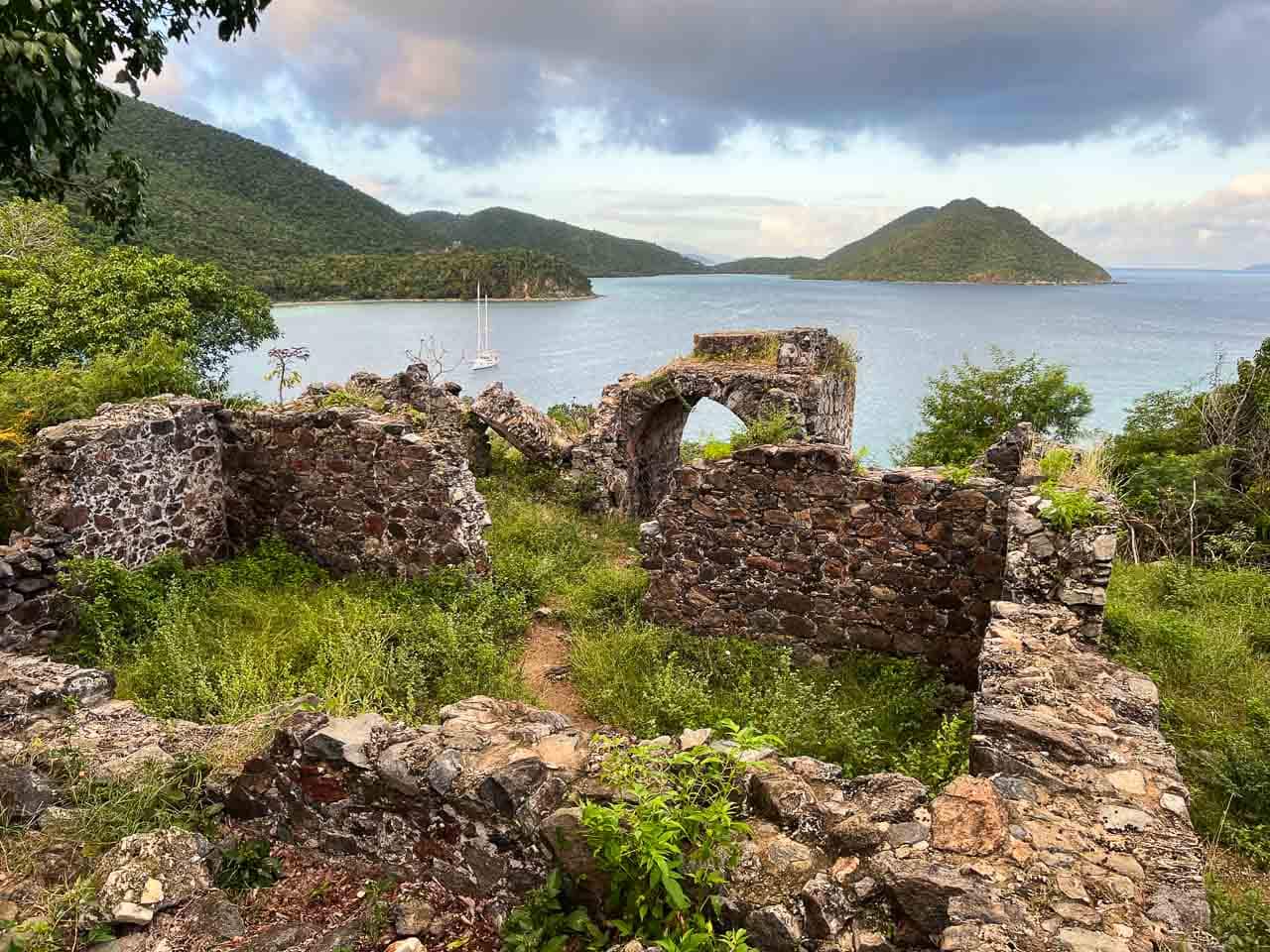
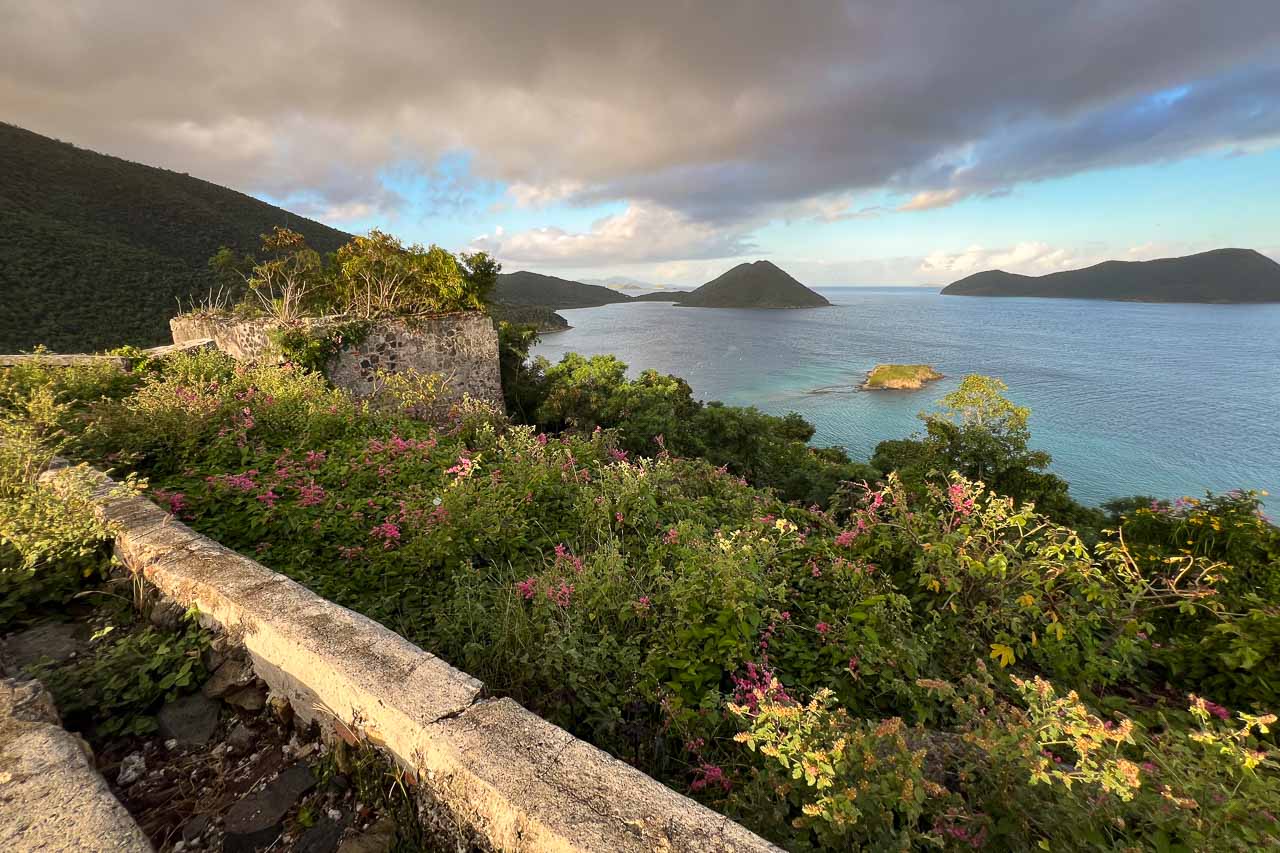
When it comes to combining intriguing history with jaw-dropping scenery, few places in Virgin Islands National Park can compete with the Murphy Great House Ruins.
Also known as the Windy Hill Ruins, this former estate stands at the top of a hill that overlooks Waterlemon Bay on the island’s north shore.
Affiliated with the nearby Annaberg Sugar Plantation, this great house is named after James Murphy, a late-18th-and-early-19th-century Irish merchant, ship owner, and slave trader. He’s widely considered to be “one of the most significant planters on St. John around the turn of the nineteenth century.”
Murphy acquired Waterlemon Bay in 1795 and quickly renamed it Leinster Bay. He subsequently also bought nearby Annaberg, Mary’s Point, and Betty’s Point, and began constructing what would become the sprawling Annaberg Sugar Plantation, part of his huge Leinster Bay Estate.
The Murphy Great House was the former home of James Murphy. It offers spectacular views of Waterlemon/Leinster Bay, Waterlemon Cay, and the Sir Francis Drake Channel.
You can get there from Annaberg via the easy Leinster Bay Trail, followed by a short section of the relatively steep Johnny Horn Trail.
The roundtrip hike is 2.4 miles and takes about 1 hour (or more if you’re spending some time at remote Waterlemon Bay Beach below the hill).
2. Cinnamon Bay Plantation Ruins
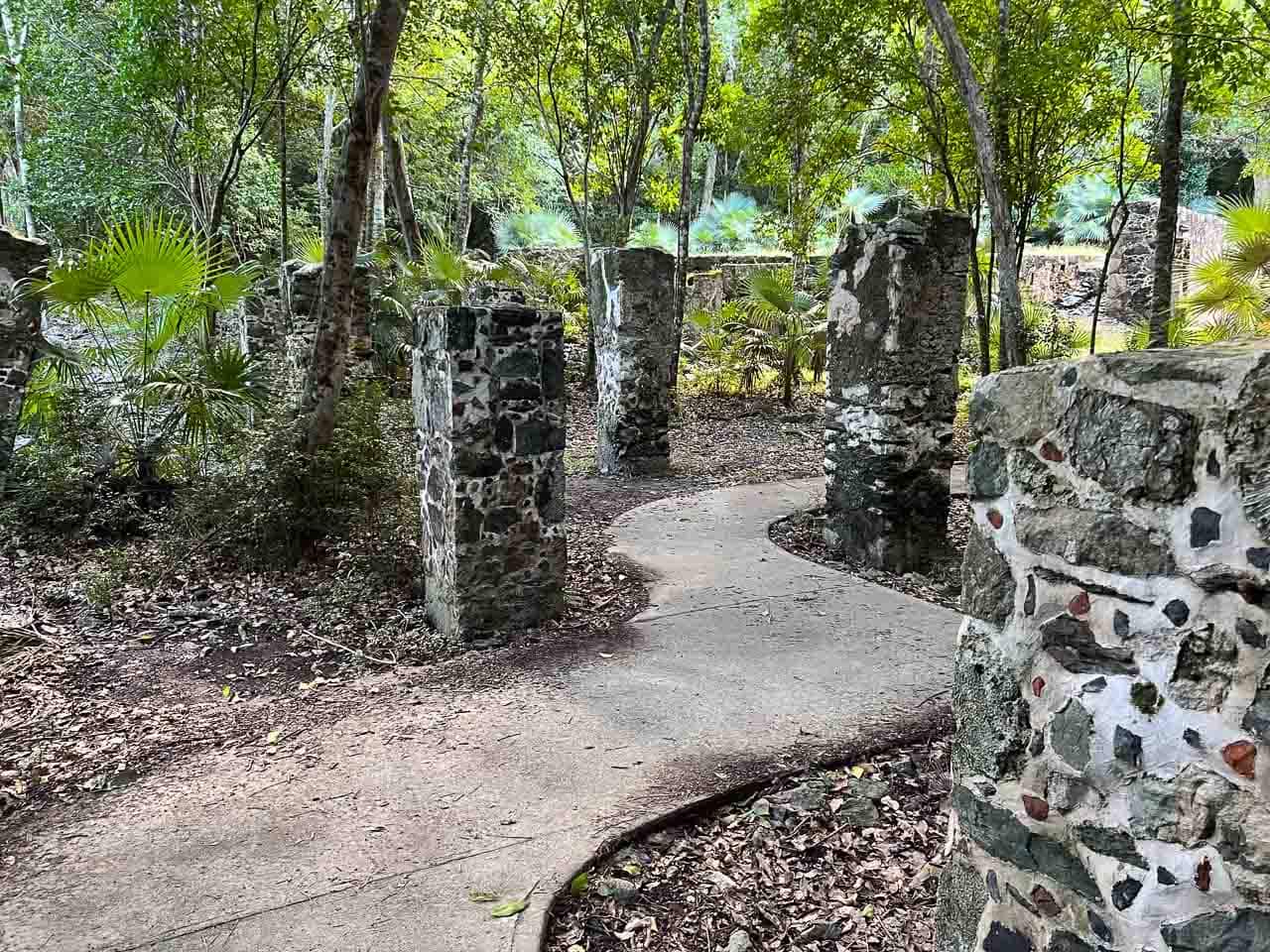
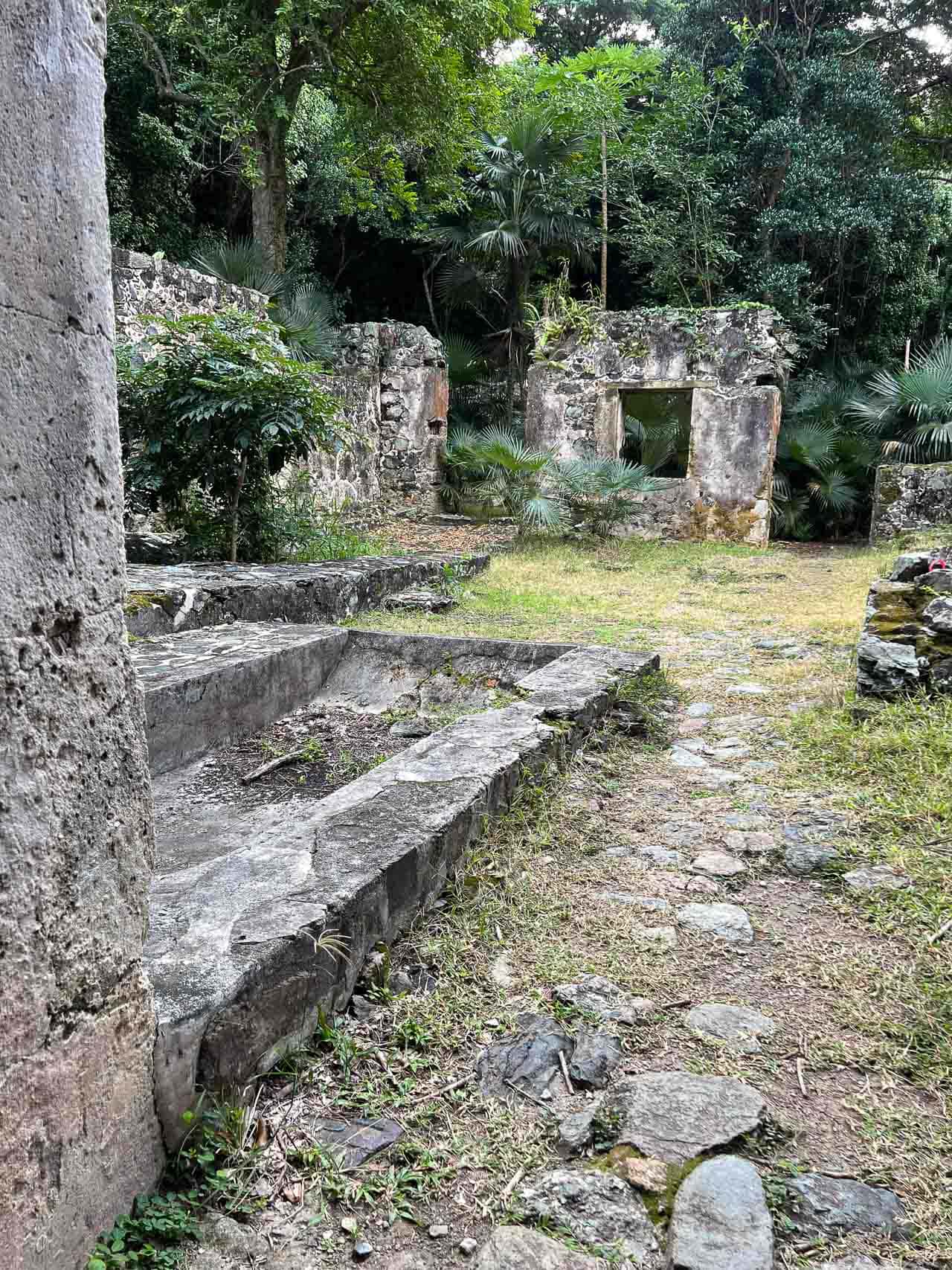
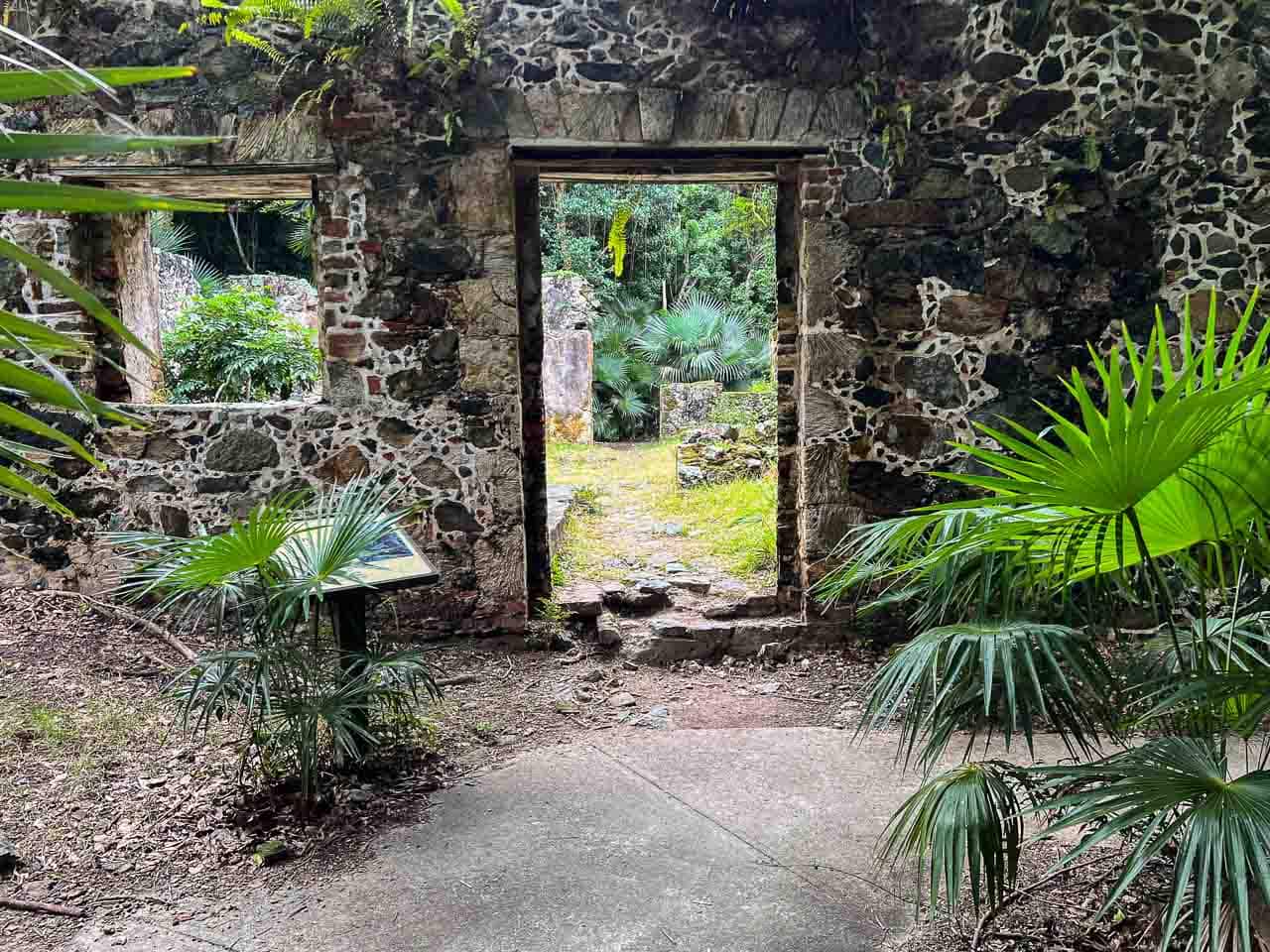
One of the easiest hikes in Virgin Islands National Park, the Cinnamon Bay Sugar Plantation Nature Loop is only half a mile long, but it’s fascinating, nonetheless.
This loop hike, comprised of a boardwalk and gravel path through the woods, takes you through and around the historic Cinnamon Bay Sugar Plantation Ruins.
Established in 1717 by the Danes, this sugar plantation was one of the first of its kind on St. John and tells the story of sugar cane production and slavery in the 18th-century Danish West Indies.
When walking the nature loop, you can explore the ruins, which include a horse mill, factory building, slave quarters, a warehouse, cemeteries, plantation house, and cook house.
Note the scent of bay rum trees as you make your way around the trail, which were once used to produce the famous St. John Bay Rum Cologne.
The trailhead of the Cinnamon Bay Sugar Plantation Nature Loop is across North Shore Road from the parking lot at the Cinnamon Bay Beach & Campground.
NEARBY: Cinnamon Bay Estate House Ruins
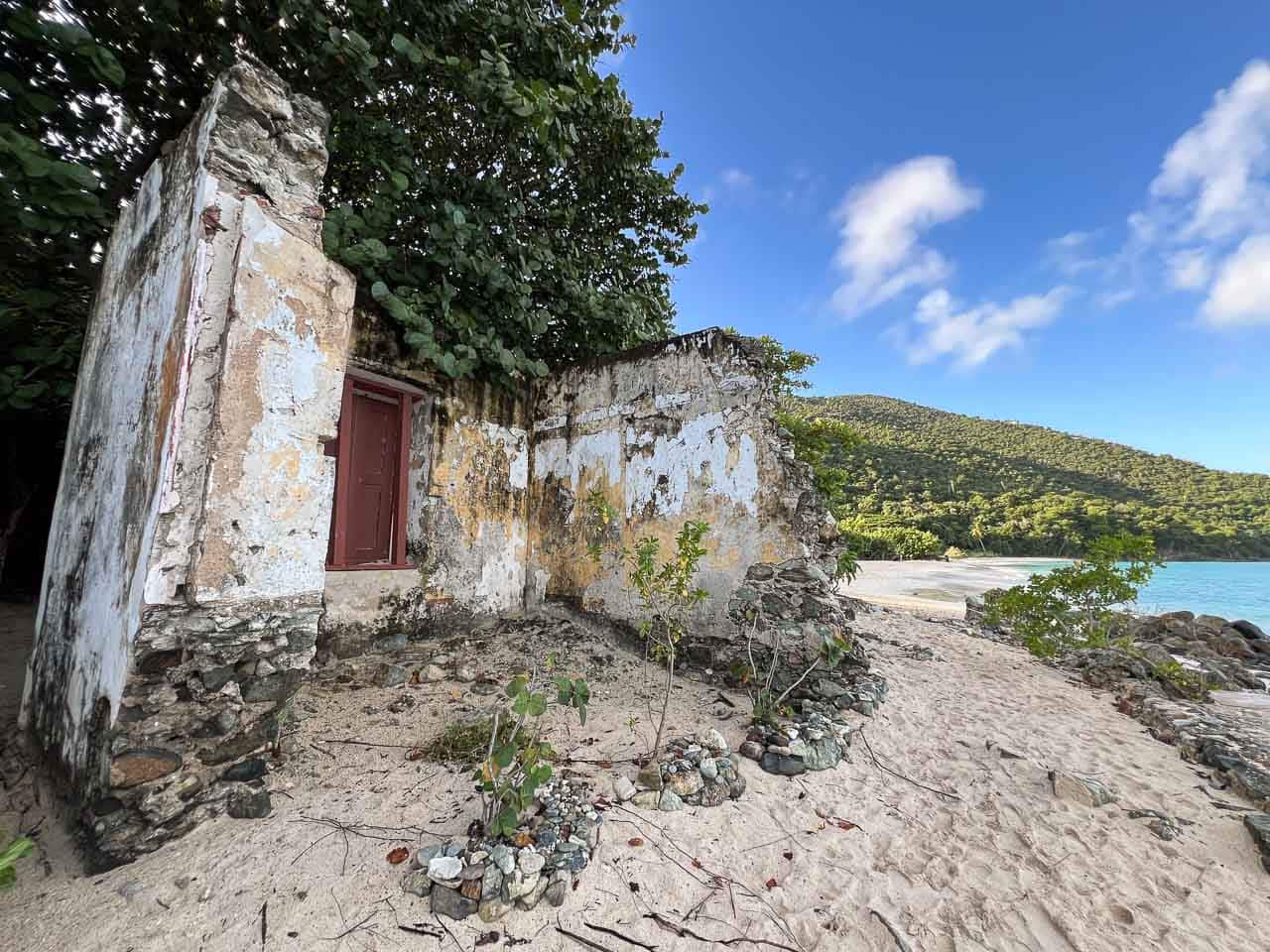
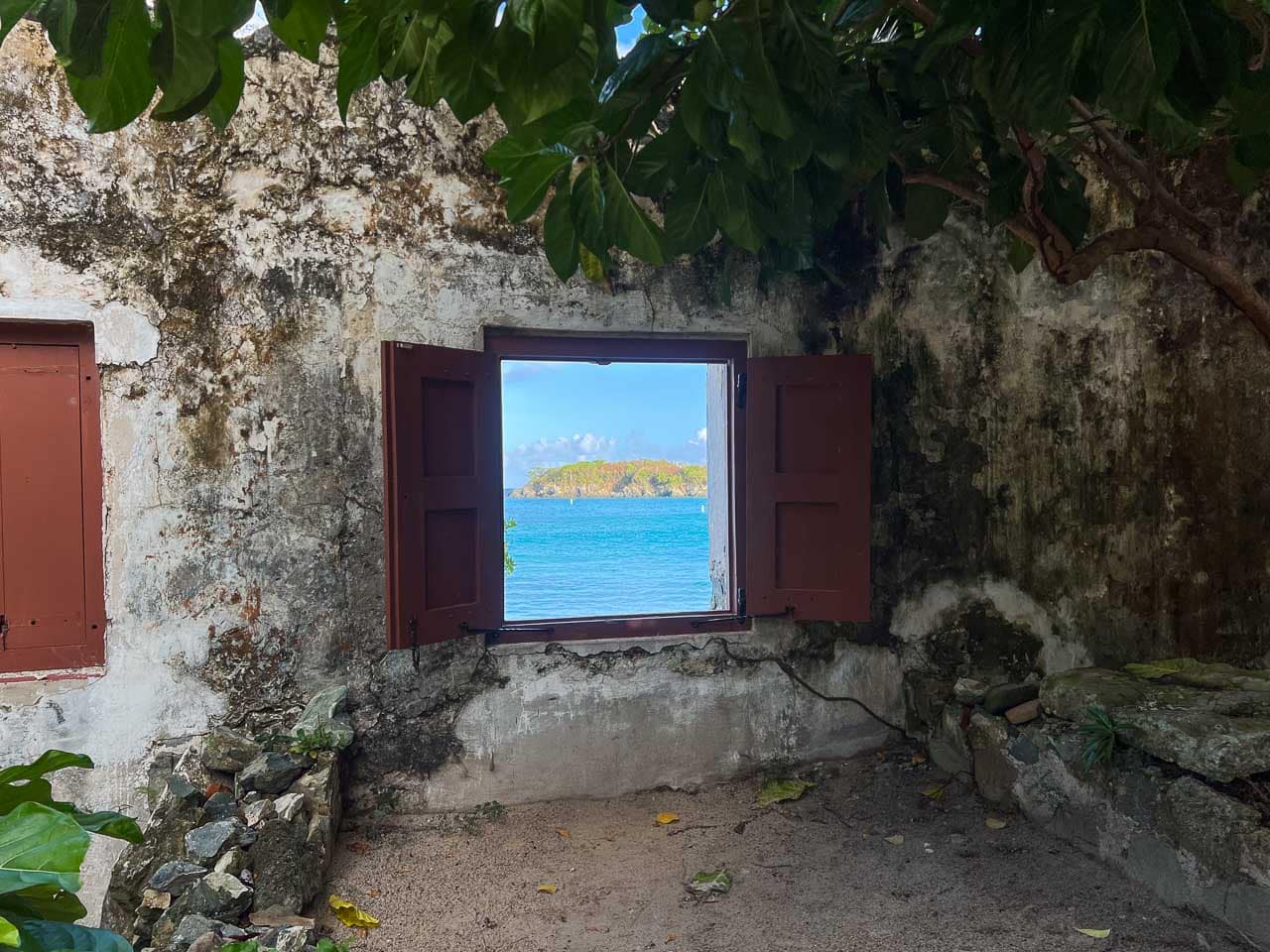
After exploring the Cinnamon Sugar Plantation Ruins, and maybe hiking the Cinnamon Bay Trail to America Hill, I recommend heading to Cinnamon Bay Beach for some well-earned beach time. Along the beach, you’ll find more historic ruins, particularly the remains of the Cinnamon Bay Estate House.
1. Annaberg Sugar Plantation Ruins
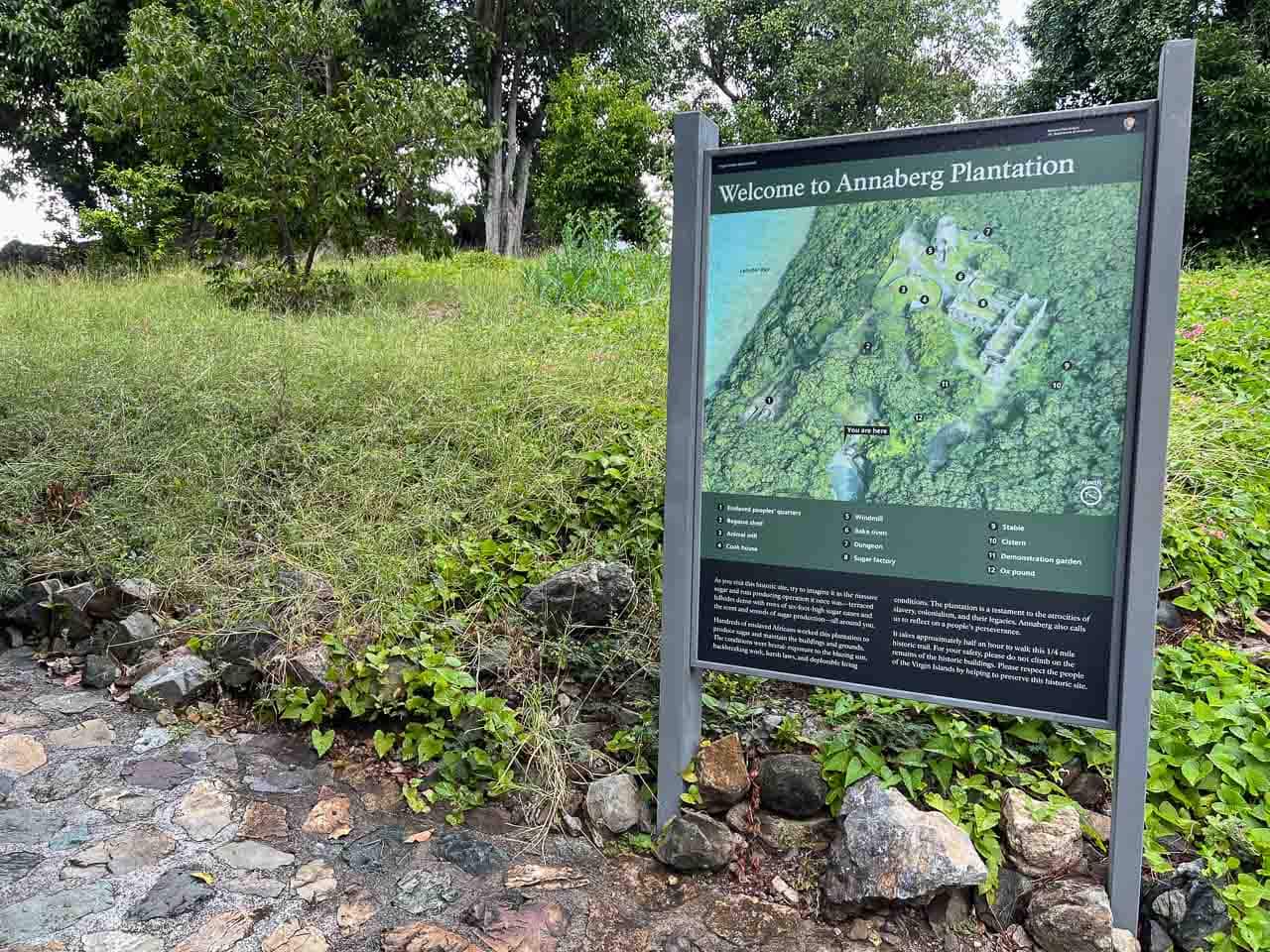
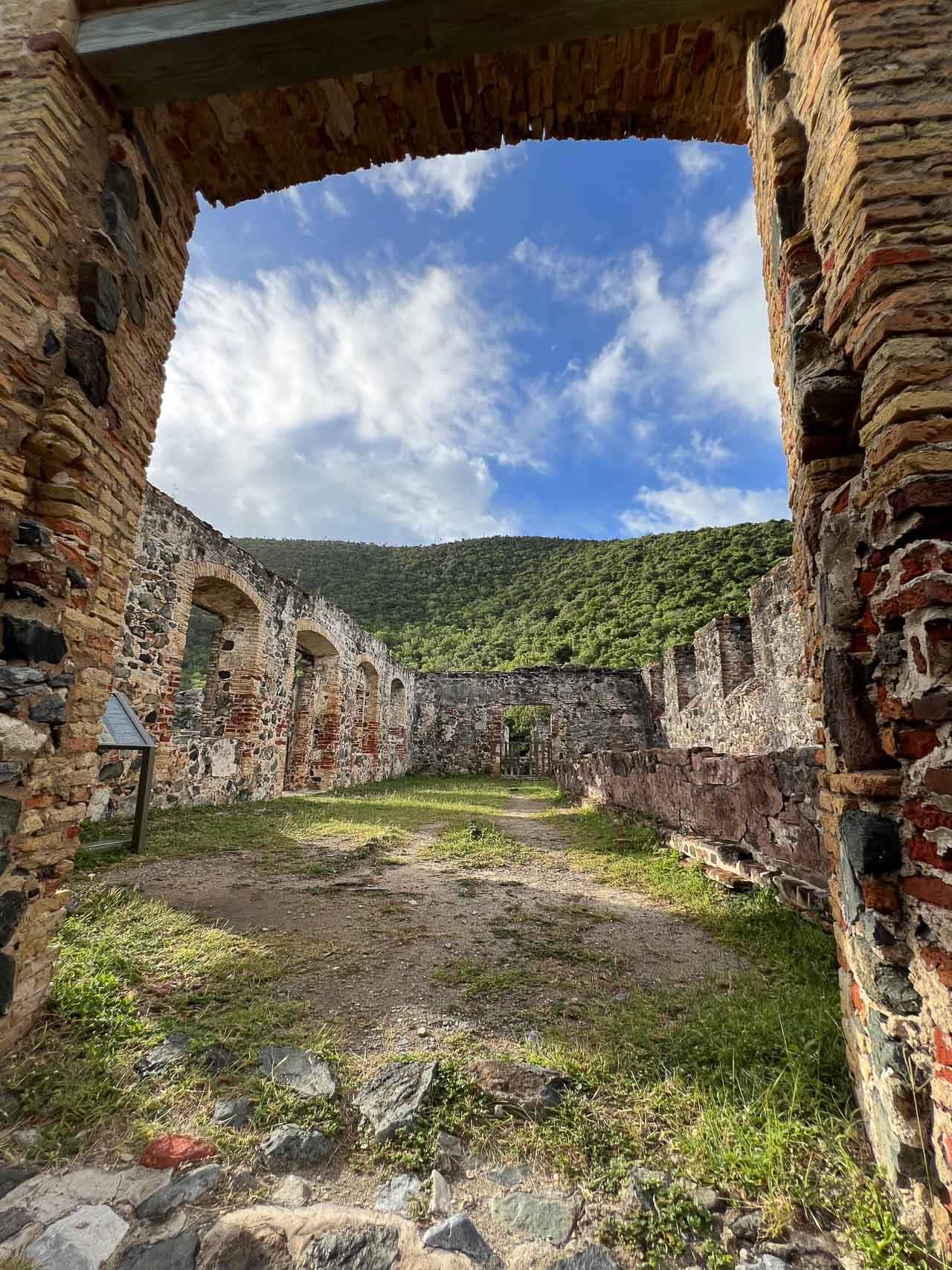
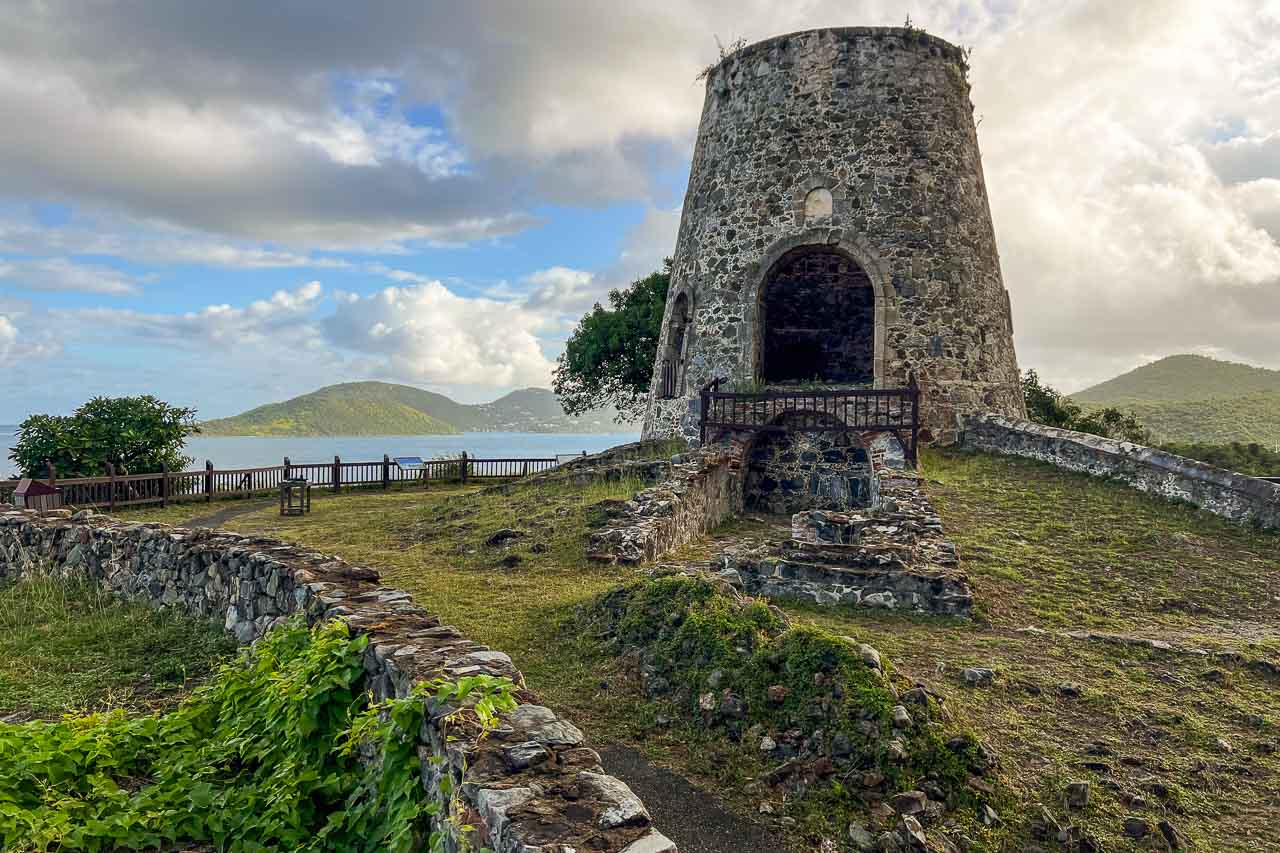
Of all these amazing ruins in Virgin Islands National Park, there’s one that’s head and shoulders above the rest: the Annaberg Sugar Plantation.
During its heyday in the 18th and 19th centuries, Annaberg was the “largest sugar producing estate on St. John,” according to the National Park Service. “At the height of Annaberg’s production, over 600 enslaved persons lived and worked the plantation.”
The plantation was built upon the Leinster Bay waterfront, which is now part of the National Underground Railroad Network to Freedom. Numerous enslaved people who lived on St. John used this very shoreline to escape to nearby Tortola in the British Virgin Islands.
As the most accessible and developed plantation ruins in the park, it’s easily the best place to learn about the history of sugar production and slavery on St. John. You can do so on an easy quarter-mile loop trail, which is lined with interpretive signs and information panels.
In addition to telling the story of slavery in the Virgin Islands, Annaberg also stands as a reminder of the displacement of Indigenous people on St. John, as well as settlement by Europeans.
“As you traverse this historic trail, imagine sugar being processed from cane and sense the spirits of the people who lived, worked, and died here,” the National Park Service says about visiting the Annaberg Sugar Plantation Ruins.
The excellent Annaberg historic trail takes you past several buildings that once made up the plantation, including the striking windmill tower, sugar factory, and slave quarters.
I recommend setting aside at least half an hour to immerse yourself in this historically important site. It’s without question one of the top attractions in Virgin Islands National Park and missing it would really be a shame.
Map of Must-Visit Historic Ruins in Virgin Islands National Park
This map shows the general location of each of the seven historic sites and sugar plantation ruins in Virgin Islands National Park described above.
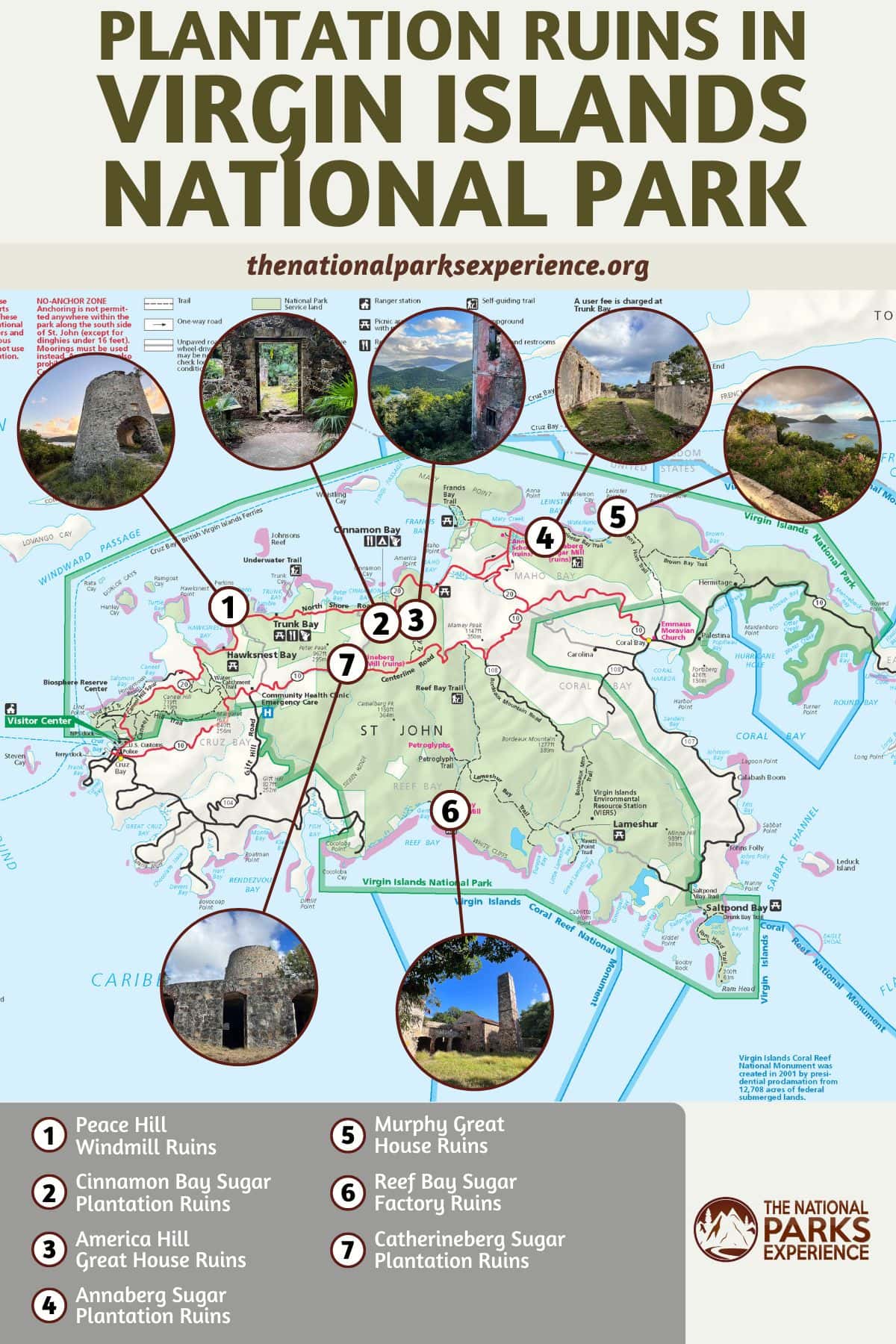
More About Virgin Islands National Park
- Park Website
- Travel Guide
- Topographic Map
- Best Time to Visit Virgin Islands National Park
- Most Beautiful Beaches in Virgin Islands National Park
- Best Views in Virgin Islands National Park
- Best Hikes in Virgin Islands National Park
- Virgin Islands National Park Snorkeling Guide
- Accommodation

